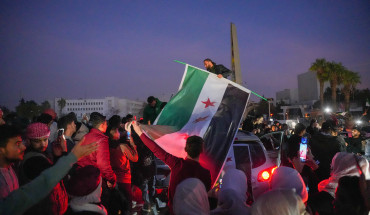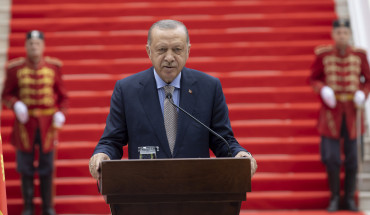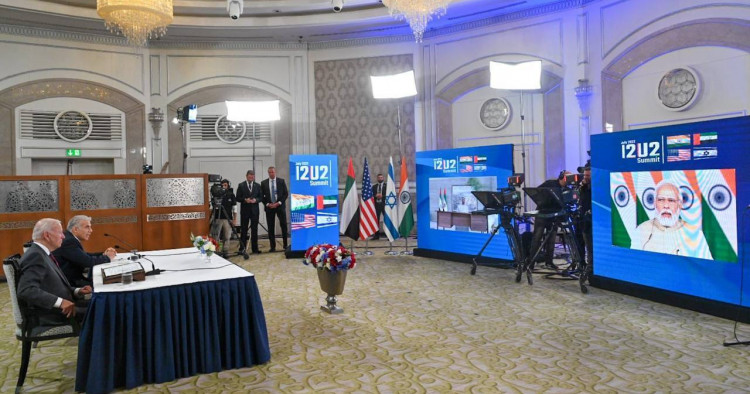The establishment of the I2U2 Group, composed of India, Israel, the United Arab Emirates (UAE), and the United States, represents a new kind of international politics in an era of transition — a politics defined by pragmatism and diversified partnerships and conducted through an array of flexible minilateral platforms. This article situates the formation of this new grouping within the Biden administration’s broader effort to elaborate its US Indo-Pacific Strategy and reframe US engagement with the Middle East/West Asia.
Minilateralism and the Indo-Pacific Strategy
The Indo-Pacific is an area increasingly recognized as the key to shaping the international order in the 21st century. Framed in geopolitical terms, the Indo-Pacific is an arena that is progressively being defined by US-China great-power competition and that has emerged as a counter-concept to China’s Belt and Road Initiative (BRI) and expanding military footprint.
The February 2022 US Indo-Pacific Strategy (IPS) emphasizes that there is no region of greater consequence to the world and states that China’s “coercion and aggression … is most acute in the Indo-Pacific.”[1] Nevertheless, the Biden administration has sought to frame the IPS as an affirmative vision of regional order designed to address not just the ‘China challenge’ but an array of threats, including climate change, Covid-19, and natural disasters.
The Biden administration has advanced an interregional approach to the Indo-Pacific that relies on “a latticework of alliances and partnerships.”[2] Minilateral platforms have come to occupy a prominent place within this latticework, whose construction is ongoing. Comprised of a relatively small number of participants, minilateral groupings are “informal, non-binding, purpose-built partnerships, and coalitions of the interested, willing, and capable set up to address challenges in specific issue areas.”[3]
The current architecture of the US approach to the Indo-Pacific includes several such groupings — notably, the Quadrilateral Security Dialogue (QSD), AUKUS, and the Five Eyes (FVEY) intelligence-sharing arrangement — overlaid upon the traditional ‘hub-and-spoke’ alliance system in Asia and augmented by the Indo-Pacific Economic Framework (IPEF). The Quad — having been elevated to the leader level and shaped into a problem-solving mechanism in multiple sectors — has emerged as the centerpiece of the Biden administration’s strategy. The Quad’s agenda has expanded to include economic and nontraditional security issues and the discourse around it has been scrubbed of overt references to China, reflecting the influence of the grouping’s non-US members and the Biden administration’s willingness to try to accommodate them.
The buildout of the Indo-Pacific strategy also has a cross-bracing feature, perhaps best illustrated by Washington’s efforts to drive deeper engagement between its European and Asia-Pacific allies. The initial results of such efforts were on full display during the proceedings of the 28-30 June 2022 NATO Summit in Madrid.[4] This gathering, the first ever NATO summit attended by the Alliance’s four Asia-Pacific partners (AP4) — Australia, Japan, New Zealand, and the Republic of Korea — signaled the creation of another in the growing number of new formats for dialogue, cooperation, and coordination across regions and institutions.
There are reasons to be skeptical about how this flexible interregional architecture will operate, whether it is sustainable, and above all, what it will achieve. After all, the US and those of its allies and partners that have embraced the notion of a “free and open Indo-Pacific” have divergent strategic outlooks and priorities, which are reflected in their delineation of the region’s geographic boundaries. The US National Security Strategy (NSS) describes the region as “stretching from our [the US] Pacific coastline to the Indian Ocean.”[5] For Australia, whose strategic focus lies to its north, the Indo-Pacific extends only to the eastern Indian Ocean.[6]
However, for Japan, the entire Indian Ocean, extending to the East African coastline, lies within the region’s geographic ambit.[7] India’s definition of the geographic scope of the Indo-Pacific is similarly expansive.[8] It is therefore not surprising that there are differing views as to whether the Middle East — or West Asia — lies within or outside the boundaries of the Indo-Pacific. Neither is it surprising that for India and Japan, especially given the extent of their energy and other interests in the Gulf, the Indo-Pacific incorporates the Middle East/West Asia.
Enter the formation of the I2U2 Group — composed of India, Israel, the United States, and the United Arab Emirates (UAE). Aboard Airforce One en route to Tel Aviv in July, National Security Affairs Jake Sullivan told members of the press that “we think I2U2 can become a feature of the broader region, just as the Quad has become a central pillar of the Indo-Pacific strategy of the United States.”[9]
A Cross-Bracing Feature of the Indo-Pacific Architecture
Viewed in the context of the evolving US approach to the Indo-Pacific in an era of great-power competition, the I2U2 is the latest among several initiatives aimed at interlinking and bolstering American alliances and partnerships. Of the four members of the I2U2, India is the linchpin of efforts to build a cross-regional cooperation framework that connects West Asia and South Asia with the Pacific.
The idea of establishing the I2U2 was reportedly conceived during a casual dinner table conversation at the residence of UAE Ambassador to the United States Yousef Al Otaiba[10] and conceptualized during a virtual foreign-ministerial meeting held on October 18, 2021.[11] All four states appointed Sherpas to determine the work agenda, who have met at least half a dozen times over the past year to explore possible areas of cooperation, most recently on the sidelines of the 20 September UN General Assembly (UNGA) meeting in New York.[12]
On 14 July, President Biden convened the first Leaders-Level Summit hosted by Israel in a virtual format with Prime Minister Modi of India, Prime Minister Yair Lapid of Israel, and President Mohamed bin Zayed Al Nahyan. The summit, which culminated in the release of a concise joint statement,[13] was followed by the announcement of two initiatives. The first, which seeks to address food security, involves a $2 billion investment by the UAE in the development of a series of integrated food parks across India equipped with state-of-the-art climate-smart technologies. The second initiative is the development of a $330 million hybrid renewable energy project in Dwarka, Gujarat — a project for which the US Trade and Development Agency (USTDA) has already funded a feasibility study.
Beyond these two projects, the I2U2 group has identified six priority areas for cooperation and investment: water, energy, transportation, space, health, and food security. The group intends to mobilize private sector capital and expertise to help modernize infrastructure, develop low carbon development pathways for industries, improve public health, and promote the development of critical emerging and green technologies in the member countries.
Towards a Sturdy Yet Flexible Structure
The I2U2 has taken a meaningful step toward building a framework for cooperation, one that promises to yield initial concrete results if, and when, as envisioned, the two agreed projects are implemented. Sustaining the momentum is possible, provided that as project planning and execution get underway the four members begin to flesh out an agenda for further cooperation. Along these lines, Mohamed Soliman’s idea of building an ambitious tech agenda merits serious consideration,[14] especially as technology-related issues cut across all six areas that I2U2 members have designated as priorities.
The progressive expansion of membership to include other MENA countries, notably Egypt and Saudi Arabia, as some have advocated, also warrants consideration.[15] However, there is value to giving the current four-member structure sufficient time to solidify. A rush to membership expansion could negate the benefits of the increased capacity it would yield by making consensus and coordination more difficult to achieve. Ensuring the timely execution, cost effectiveness, and high quality of the I2U2s inaugural projects should take precedence over all else, if only because of the need to attract and build confidence among private sector partners upon whose participation the viability of these and other, future endeavors greatly depends.
Equally important is to maintain, at least in the short term, the I2U2’s distinctly economic agenda. Given divergent outlooks on Russia, China, and Iran among I2U2 members, it is not merely by design but of necessity that their “mutually identified” projects and priority areas for cooperation are narrowly targeted and relatively uncontroversial. The quartet’s members have steered away from overt geopolitical references in their official statements and press releases. But by choosing to focus on food and energy security, I2U2 member states have found a way to address the consequences of the war in Ukraine without explicitly mentioning or compromising the positions they have staked out on the conflict.
That said, geopolitical dynamics and motivations are not far from the surface. For the Biden administration, the I2U2 quartet is undoubtedly aimed at serving strategic purposes, ranging from the desire to revitalize relations with MENA allies and partners, to helping advance Israel’s integration into the region and countering China’s expanding presence and influence in the Middle East. But the fact that the Biden administration has placed more emphasis on developing a positive agenda for functional cooperation based on shared interests than on driving a transparently anti-Iran and/or anti-China agenda is noteworthy — and prudent. Only by meeting its partners where they are can Washington realistically expect the fledgling group to bring projects to completion and thereby build the trust and habits of cooperation that might lend themselves to the pursuit of more ambitious aims.
Here, it is important to emphasize that despite having different political systems and lacking a common threat, I2U2 members have robust bilateral relationships among themselves, including cooperation in intelligence sharing and cybersecurity. In fact, bilateral partnerships among the members of the quartet are not only thriving but growing. The India-Israel strategic relationship, for years anchored in agri-tech and the arms trade, is deepening.[16] In May of this year, the India-UAE Comprehensive Economic Partnership Agreement (CEPA) entered into force.[17] The same month, Israel and UAE signed a free trade agreement (FTA).[18] The I2U2 should thus be viewed as an extension and bolstering of these bilateral partnerships. And while neither the US nor the other three members of the quarter have introduced geopolitical objectives, the formation of the I2U2 has created new avenues for enhancing their strategic interactions.
The emergence of India as a critical Indo-Pacific partner through the Quad and as the stable eastern pole in a web of Middle East/West Asian partnerships would be strategically advantageous for the United States. For this reason, India’s inclusion, and its role in the I2U2 deserves particular attention. India occupies an important place in Washington’s approach to the Indo-Pacific as well as in its efforts to reshape US engagement with MENA countries. The Biden administration’s Indo-Pacific Strategy views building on “India’s continued rise and regional leadership” as a key line of effort.[19] Responding to a reporter’s question about bringing India into the I2U2, US National Security Adviser Jake Sullivan stated: “India plays a critical role in the Indo-Pacific. And it’s one of the largest, most significant, most strategically consequential countries in the Indo-Pacific, and so it should play a central role in our strategy …”[20] From Washington’s vantage point, India also can make a significant contribution to peace and prosperity in the MENA region — a perspective that aligns with that of the Modi administration, which has adopted a more assertive posture towards the country’s ‘extended western neighborhood.’[21]
With the international system transitioning toward multipolarity, Prime Minister Modi has set a course for India to assume a greater role in in world affairs, commensurate with its status as a rising power. New Delhi’s renewed interest in The Quad, along with the decisions to join the I2U2 and, more recently the IPEF, reflect this broader recalibration of Indian foreign policy. But it would be a mistake to interpret India’s participation in any one or several interlinked groupings as evidence that New Delhi is on the verge of detaching itself from the moorings of the country’s long-held commitment to strategic autonomy. The multi-alignment strategy embraced by the BJP-led Modi administration flows from the conviction that “India must reach out in as many directions as possible and maximize its gains,”[22] and as a result, “there will be convergence with many but congruence with none.”[23] The Biden administration appears to recognize that although the US-India relationship is likely to consist simultaneously of partnership and dissent and is not about to be transformed into an alliance, that New Delhi’s preference for forming and joining multiple groupings nonetheless can be leveraged to pursue pragmatic cooperation.
Conclusion
The I2U2 is the most recent of several minilateral initiatives by the Biden administration aimed at revitalizing, reframing, and bridging American alliances and partnerships. Launched without fanfare at the Leaders-Level Summit in July, which was billed as an exploratory meeting, the I2U2 has adopted a distinctly economic orientation — the very feature that has allowed the grouping to coalesce, given its members’ divergent views on some of the major strategic issues. The cohesiveness and sustainability of the I2U2 can best be assured by bringing its initial joint projects to fruition while simultaneously developing a more expansive though no less positive agenda for practical cooperation. Increasing the size of the fledgling I2U2 and endowing it with a military security role might well serve long-term US interests. Yet, in seeking to advance its interests at this nascent stage of the group’s evolution, Washington might find patient resolve to be more of an asset than ambition.
[1] White House, Indo-Pacific Strategy of the United States (February 2022): 5, https://www.whitehouse.gov/wp-content/uploads/2022/02/U.S.-Indo-Pacific-Strategy.pdf.
[2] Ibid., 9.
[3] S-M Kim, S. Haug, and S.H. Rimmer, “Minilateralism Revisited: MIKTA as Slender Diplomacy in a Multiplex World,” Global Governance 24, 4 (2018): 478.
[4] At the Madrid Summit, the Alliance endorsed it new ‘strategic concept,’ which for the first time includes an explicit reference to China, describing that country’s “stated ambitions and coercive policies” as a challenge to NATO’s “interests, security and values.” NATO 2022 Strategic Concept (June 22, 2022): 5, https://www.nato.int/nato_static_fl2014/assets/pdf/2022/6/pdf/290622-strategic-concept.pdf
[5] White House, Indo-Pacific Strategy of the United States (February 2022): 4, https://www.whitehouse.gov/wp-content/uploads/2022/02/U.S.-Indo-Pacific-Strategy.pdf.
[6] Government of Australia, Department of Foreign Affairs and Trade (DFAT), 2017 Foreign Policy White Paper (2017): 119, https://www.dfat.gov.au/sites/default/files/2017-foreign-policy-white-paper.pdf.
[7] See, for example: “Japan's foreign minister heads to East Africa in Indo-Pacific push,” Nikkei Asia, December 5, 2020, https://asia.nikkei.com/Politics/International-relations/Indo-Pacific/Japan-s-foreign-minister-heads-to-East-Africa-in-Indo-Pacific-push.
[8] Government of India, Ministry of External Affairs, “Prime Minister’s Keynote Address at Shangri La Dialogue,” June 1, 2018, https://www.mea.gov.in/Speeches-Statements.htm?dtl/29943/Prime+Ministers+Keynote+Address+at+Shangri+La+Dialogue+June+01+2018.
[9] The White House, “Press Gaggle by Press Secretary Karine Jean-Pierre and National Security Advisor Jake Sullivan En Route Tel Aviv, Israel,” Press Briefings, July 13, 2022, https://www.whitehouse.gov/briefing-room/press-briefings/2022/07/13/press-gaggle-by-press-secretary-karine-jean-pierre-and-national-security-advisor-jake-sullivan-en-route-tel-aviv-israel/.
[10] “I2U2 sends out a new message of cooperation,” Gulf Today, July 15, 2022, https://www.gulftoday.ae/opinion/2022/07/15/i2u2-sends-out-a-new-message-of-cooperation.
[11] US Department of State, Office of the Spokesperson, “Secretary of State Antony J. Blinken’s Meeting with Emirati Foreign Minister Sheikh Abdullah bin Zayed, Indian External Affairs Minister Dr. Subrahmanyam Jaishankar, and Israeli Foreign Minister and Alternate Prime Minister Yair Lapid,” October 18, 2021, https://www.state.gov/secretary-of-state-antony-j-blinkens-meeting-with-emirati-foreign-minister-sheikh-abdullah-bin-zayed-indian-external-affairs-minister-dr-subrahmanyam-jaishankar-and-israeli-foreign-minist/.
[12] The designated Sherpas are US Under Secretary for Economic Growth, Energy, and the Environment Jose W. Fernandez; India’s Secretary (Economic Relations) in the Ministry of External Affairs Shri Dammu Ravi; UAE Minister of State Ahmed bin Ali Al Sayegh; and DG of Israel’s Ministry of Foreign Affairs, Alon Ushpiz. See https://mea.gov.in/press-releases.htm?dtl/35489/First+I2U2+IndiaIsraelUAEUSA+Leaders+Virtual+Summit; and US Department of State, Office of the Press Spokesman, “Under Secretary Fernandez Convenes I2U2 Counterparts from India, the UAE, and Israel,” September 20, 2022, https://www.state.gov/under-secretary-fernandez-convenes-i2u2-counterparts-from-india-the-uae-and-israel-on-the-margins-of-unga-77/.
[13] White House, “Joint Statement of the Leaders of India, Israel, United Arab Emirates, and the United States (I2U2),” July 14, 2022, https://www.whitehouse.gov/briefing-room/statements-releases/2022/07/14/joint-statement-of-the-leaders-of-india-israel-united-arab-emirates-and-the-united-states-i2u2/.
[14] Mohammed Soliman, “The I2U2 needs an ambitious tech agenda,” Middle East Institute, September 19, 2022, https://www.mei.edu/publications/i2u2-needs-ambitious-tech-agenda.
[15] C. Raja Mohan, “Making a case for Indo-Abrahamic accord,” Indian Express, August 3, 2021, https://indianexpress.com/article/opinion/columns/india-middle-east-relations-israel-uae-abraham-accords-7435298/; and Mohammed Soliman, “Egypt and India: Time to rebuild relations,” Middle East Institute, May 26, 2022, https://www.mei.edu/publications/egypt-and-india-time-rebuild-relations; Gokul Sahni and Mohammed Soliman, “India, Saudi Arabia, and the Indo-Abrahamic Plus,” Observer Research Foundation (ORF), July 12, 2022, https://www.orfonline.org/expert-speak/india-saudi-arabia-and-the-indo-abrahamic-plus/; and Mohammed Soliman, “The I2U2 needs muscle. Cairo and Riyadh can help,” Middle East Institute, August 22, 2022, https://www.mei.edu/publications/i2u2-needs-muscle-cairo-and-riyadh-can-help.
[16] Jayant Prasad and S. Samuel C. Rajiv (eds.), India and Israel: The Making of a Strategic Partnership (London, UK: Routledge, 2020).
[17] Government of India, Ministry of Commerce & Industry, “India-UAE Comprehensive Economic Partnership Agreement (CEPA) enters into force,” May 22, 2022, https://pib.gov.in/PressReleasePage.aspx?PRID=1821785.
[18] “Israel signs first Arab free trade agreement with UAE,” Aljazeera, May 31, 2022, https://www.aljazeera.com/economy/2022/5/31/israel-signs-major-trade-deal-with-uae.
[19] White House, Indo-Pacific Strategy of the United States (February 2022): 19, https://www.whitehouse.gov/wp-content/uploads/2022/02/U.S.-Indo-Pacific-Strategy.pdf.
[20] The White House, “Press Gaggle by Press Secretary Karine Jean-Pierre and National Security Advisor Jake Sullivan En Route Tel Aviv, Israel,” Press Briefings, July 13, 2022, https://www.whitehouse.gov/briefing-room/press-briefings/2022/07/13/press-gaggle-by-press-secretary-karine-jean-pierre-and-national-security-advisor-jake-sullivan-en-route-tel-aviv-israel/.
[21] Pramit Pal Chaudhuri, “Think West to Go West: Origins and Implications of India’s West Asia Policy Under Modi (Part I),” Middle East Institute, September 26, 2017, https://www.mei.edu/publications/think-west-go-west-origins-and-implications-indias-west-asia-policy-under-modi-part-i.
[22] S. Jaishankar, The India Way: Strategies for an Uncertain World (Noida: HarperCollins Publishers India, 2020), 42.
[23] Ibid., 41.
The Middle East Institute (MEI) is an independent, non-partisan, non-for-profit, educational organization. It does not engage in advocacy and its scholars’ opinions are their own. MEI welcomes financial donations, but retains sole editorial control over its work and its publications reflect only the authors’ views. For a listing of MEI donors, please click here.












